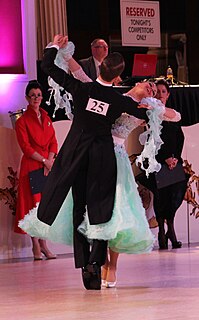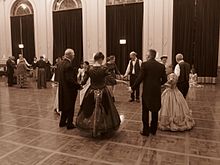
Ballroom dance is a set of partner dances, which are enjoyed both socially and competitively around the world, mostly because of its performance and entertainment aspects. Ballroom dancing is also widely enjoyed on stage, film, and television.

Modern social round dance, or round dancing, is a choreographed and cued ballroom dance that progresses in a circular counter-clockwise pattern around the dance floor. The two major categories of ballroom dances found in round dancing are the smooth and international ballroom styles and the Latin dances. It is not to be confused with circle dancing, which is a type of folk dance in which dancers are connected in a circular chain.
This is a list of dance terms that are not names of dances or types of dances. See List of dances and List of dance style categories for those.

The quickstep is a light-hearted dance of the standard ballroom dances. The movement of the dance is fast and powerfully flowing and sprinkled with syncopations. The upbeat melodies that quickstep is danced to make it suitable for both formal and informal events. Quickstep was developed in the 1920s in New York City and was first danced by Black Americans. Its origins are in combination of slow foxtrot combined with the Charleston, a dance which was one of the precursors to what today is called swing dancing.
Formation dance is a style of ballroom dancing. It is pattern or shadow team dancing by couples in a formation team. The choreography may be based on a particular dance or a medley of dances. Formation dancing may be done for exhibition or for competition between teams. There is also a type of formation in Bhangra.
Superior Dancing is a series of compilation CD albums dedicated to ballroom dances released by Kondor Musikvertrieb GmbH, Germany. They contain music for International Style ballroom dances.

Victor Marlborough Silvester OBE was an English dancer, writer, musician and bandleader from the British dance band era. He was a significant figure in the development of ballroom dance during the first half of the 20th century, and his records sold 75 million copies from the 1930s through to the 1980s.
Swedish Dancesport Federation (DSF) administers all dancesport in Sweden. The association was formed on February 25, 1968, and is one of 68 different sports federations in Sweden. DSF became a member of the Swedish Sports Confederation (RF) in 1977, which administers all sports in Sweden. Apart from this membership Swedish Dancesport Federation also is a member of the International Dancesport Federation (IDSF) from June 19, 2011 known as the World DanceSport Federation (WDSF) and the World Rock'n'Roll Confederation (WRRC). The office lies in Farsta, Stockholm.
Strictly Come Dancing returned for its fourth series on 7 October 2006 and ended on 23 December. Bruce Forsyth and Tess Daly returned to co-present the main show on BBC One, whilst Claudia Winkleman returned to present spin-off show Strictly Come Dancing: It Takes Two on BBC Two for the third series in a row. Len Goodman, Bruno Tonioli, Craig Revel Horwood and Arlene Phillips returned as judges. The winner was Mark Ramprakash and his dancing partner Karen Hardy.
The counter promenade position is a dance position in ballroom and other dances. It is described differently in various dance categories, but essentially it is the opposite of the promenade position.
America's Ballroom Challenge is a competitive ballroom dance television series that aired on Public Broadcasting Service in the United States between 2006 and 2009.
The Australian TV series Dancing with the Stars premiered on Tuesday 5 October 2004 and concluded on Tuesday 23 November 2004. Home and Away star Bec Hewitt and partner Michael Mizner won the series, with politician Pauline Hanson and her partner Salvatore Vecchio as runner-up.
Strictly Come Dancing aired its first series on BBC One from 15 May 2004. The series was presented by Bruce Forsyth and Tess Daly. The judging panel was Craig Revel Horwood, Arlene Phillips, Len Goodman and Bruno Tonioli.
Strictly Come Dancing returned for its second series on 23 October 2004 on BBC One. Bruce Forsyth and Tess Daly returned to present the main show on BBC One, while Claudia Winkleman presented a new spin-off show called Strictly Come Dancing: It Takes Two on BBC Two. Series 1 winner Natasha Kaplinsky filled in for Daly during the first five weeks due to maternity leave. Len Goodman, Bruno Tonioli, Craig Revel Horwood and Arlene Phillips returned to the judging panel.
The 10th season of Taniec z Gwiazdami, the Polish edition of Dancing With the Stars, started on 6 September 2009 and ended on 29 November 2009. It was broadcast by TVN. Katarzyna Skrzynecka and Piotr Gąsowski continued as the hosts, and the judges were: Iwona Szymańska-Pavlović, Zbigniew Wodecki, Beata Tyszkiewicz and Piotr Galiński.
The eleventh season of Dancing with the Stars premiered on Sunday 8 May 2011 at 6:30 pm on Channel Seven. Daniel MacPherson and Sonia Kruger returned as hosts, along with judges Todd McKenney and Helen Richey. Australian dancer Joshua Horner joined the judging panel as a replacement for Mark Wilson. My Kitchen Rules presenter Manu Feildel and his partner, Alana Patience, won the competition over model Haley Bracken. Alana is the first professional to win the competition twice, having won the prior season with Rob Palmer.
The 13th season of Taniec z Gwiazdami, the Polish edition of Dancing with the Stars, started on 4 September 2011 and ended in November 2011. It was broadcast by TVN. Piotr Gąsowski and Natasza Urbańska were the hosts. The judges were: Iwona Szymańska-Pavlović, Piotr Galiński and, replacing Beata Tyszkiewicz and Zbigniew Wodecki, were Jolanta Fraszyńska and Janusz Józefowicz.
The second season of the French version of Dancing with the Stars debuted on TF1 on 8 October 2011. Nine celebrities were paired with nine professional ballroom dancers. Sandrine Quétier and Vincent Cerutti return as the hosts for this season.

The fourth season of the French version of Dancing with the Stars premiered on TF1 on September 28, 2013. Like the previous season, 10 celebrities were paired with 10 professional ballroom dancers. Sandrine Quétier and Vincent Cerutti return as the hosts for this season.





